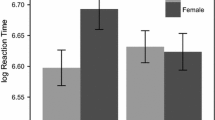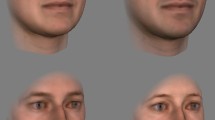Abstract
We investigated whether monkeys discriminate the sex of individuals from their pictures. Whole-body pictures of adult and nonadult monkeys were used as stimuli. Two male Japanese monkeys were trained for a two-choice sex categorization task in which each of two choice pictures were assigned to male and female, respectively. Following the training, the monkeys were presented with novel monkey pictures, and whether they had acquired the categorization task was tested. The results suggested that while monkeys discriminate between the pictures of adult males and females, discrimination of nonadult pictures was difficult. Partial presentations of the pictures showed that conspicuous and sexually characteristic parts (i.e., underbellies including male scrotums or breasts including female nipples) played an important role in the sex categorization.




Similar content being viewed by others
References
Bielert C, van der walt LA (1982) Male chacma baboon (Papio ursinus) sexual arousal: mediation by visual cues from female conspecifics. Psychoneuroendocrinology 7:31–48
Bielert C, Girolami L, Jowell S (1989) An experimental examination of the colour component in visually mediated sexual arousal of the male chacma baboon (Papio ursinus). J Zool 219:569–579
Bovet D, Washburn DA (2003) Rhesus macaques (Macaca mulatta) categorize unknown conspecifics according to their dominance relations. J Comp Psychol 117:400–405
Brown E, Perrett DI (1993) What gives a face its gender? Perception 22:829–840
Bruce V, Burton AM, Hanna E, Healey P, Mason O, Coombes A, Fright R, Linney A (1993) Sex discrimination: how do we tell the difference between male and female faces? Perception 22:131–152
Hamada Y, Suzuki J, Ohkura S, Hayakawa S (2005) Changes in testicular and nipple volume related to age and seasonality in Japanese macaques (Macaca fuscata), especially in the pre- and post-pubertal periods. Primates 46:33–45
Humphrey NK (1974) Species and individuals in the perceptual world of monkeys. Perception 3:105–114
Izumi A (2002) Auditory stream segregation in Japanese monkeys. Cognition 82:B113–B122
Izumi A (2003) Effect of temporal separation on tone-sequence discrimination in monkeys. Hear Res 175:75–81
Izumi A, Kojima S (2004) Matching vocalizations to vocalizing faces in a chimpanzee (Pan troglodytes). Anim Cogn 7:179–184
Mizuno M (1997) Mesu makauzaru ni okeru sikaku ni yoru seibennbetu to seisikousei no kennkyu (Visually-guided discrimination and preference of sexuality in female macaque monkeys). Fukuoka Igaku Zasshi 88:105–116
Ohshiba N (1995) Nihonnzaru ni yoru doushutakotai no seibennbetu (Japanese macaques’ sex discrimination of their conspecifics). Reichorui Kenkyu 11:179–186
Parr LA, de Waal FBM (1999) Visual kin recognition in chimpanzees. Nature 399:647–648
Parr LA, Winslow JT, Hopkins WD, de Waal FBM (2000) Recognizing facial cues: individual discrimination by chimpanzees (Pan troglodytes) and rhesus monkeys (Macaca mulatta). J Comp Psychol 114:47–60
Pascalis O, Petit O, Kim JH, Campbell R (1999) Picture perception in primates: the case of face perception. Curr Psychol Cogn 18:889–921
Petit O, Thierry B (1992) Affiliative function of the silent bared-teeth display in moor macaques (Macaca Maurus): further evidence for the particular status of Sulawesi macaques. Int J Primatol 13:97–105
Quinn PC, Yahr J, Kuhn A, Slater AM, Pascalis O (2002) Representation of the gender of human faces by infants: a preference for female. Perception 31:1109–1121
Rendall D, Owren MJ, Weerts E, Hienz RD (2004) Sex differences in the acoustic structure of vowel-like grunt vocalizations in baboons and their perceptual discrimination by baboon listeners. J Acoust Soc Am 115:411–421
Wild HA, Barrett SE, Spence MJ, O’Toole AJ, Cheng YD, Brooke J (2000) Recognition and sex categorization of adults’ and children's faces: examining performance in the absence of sex-stereotyped cues. J Exp Child Psychol 77:269–291
Acknowledgements
This work was supported by a Grant for Biodiversity Research of the 21st Century COE (A14, Kyoto University) from the Ministry of Education, Culture, Sports, Science and Technology of Japan. The authors are grateful to Nobuo Masataka and Sumiharu Nagumo for support throughout the research. Thanks are also extended to Akemi Kato and Satomi Araya for assistance and the daily care of the monkeys and to Jean-Baptiste Leca for the generous offer of pictures of the Arashiyama troop. The present study complies with the laws of Japan.
Author information
Authors and Affiliations
Corresponding author
Rights and permissions
About this article
Cite this article
Koba, R., Izumi, A. Sex categorization of conspecific pictures in Japanese monkeys (Macaca fuscata). Anim Cogn 9, 183–191 (2006). https://doi.org/10.1007/s10071-006-0020-0
Received:
Revised:
Accepted:
Published:
Issue Date:
DOI: https://doi.org/10.1007/s10071-006-0020-0




